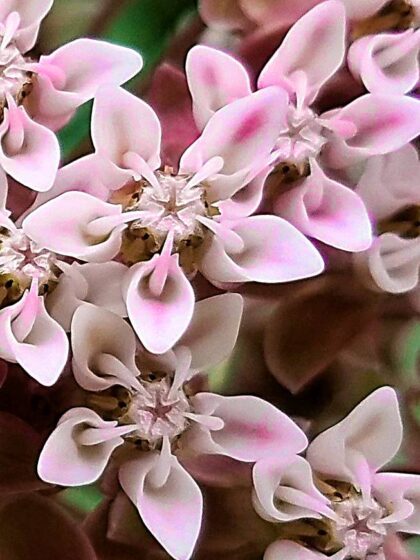Happy Mystery Monday!
Can you guess what is pictured in photo #1?

The answer to last week’s mystery is milkweed, Asclepias, pictured in photo #2.

Unlike most flowers, milkweed does not produce loose pollen, but waxy, sticky balls of pollen called pollinia. Each milkweed blossom has a small slit leading down a chamber to the pollinia. When insects land on the droopy milkweed flowers, clinging to the petals as they feed on nectar, a foot can slip into the slit and come in contact with pollinia. When an insect pulls its foot out of the slit, it brings the pollinium with it. Should that same foot slip into another milkweed flower’s slit, the pollen can be transferred, facilitating fertilization.
Milkweed plants typically produce a lot of nectar. The nectar replenishes overnight, gratifying nocturnal moths. The remaining nectar is ready for the first diurnal visitors in the morning.
To access nectar, floral visitors prop themselves on one of the five flower hoods, sliding their tongues down the side of the hood where the nectar is held. They must be careful not to slip their leg down into the flower between the slits. Sometimes insects get stuck in a slit and are never able to free themselves. Some insects are not robust enough to remove their legs from the anther slits with the attached pollinia and are trapped to die there if they don’t lose their appendage first. Other times, they must tear off their own limbs to escape. Even if an insect does manage to pry its leg out of the trap door, some insects are unable to remove the pollinia.
One or two pollinia will slow an insect down, but too many can make it difficult to move. Despite the potential harm of visiting a milkweed flower, for many insects, this is a reliable source of nectar that is worth the risk.
Mystery Monday is sponsored by the Spy Newspapers and Adkins Arboretum.



Write a Letter to the Editor on this Article
We encourage readers to offer their point of view on this article by submitting the following form. Editing is sometimes necessary and is done at the discretion of the editorial staff.